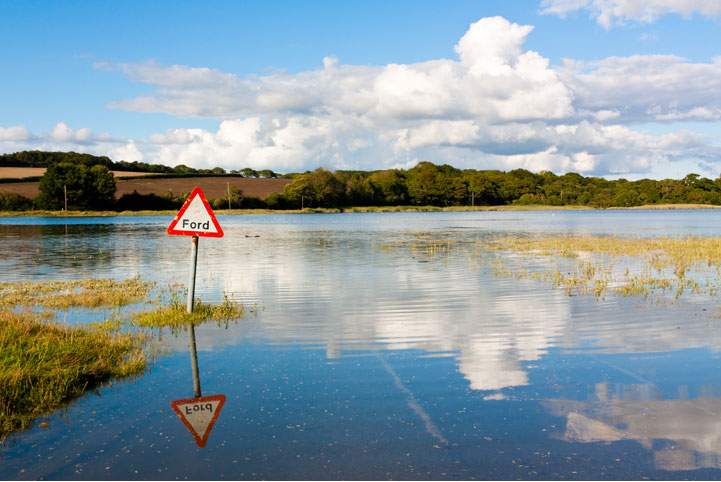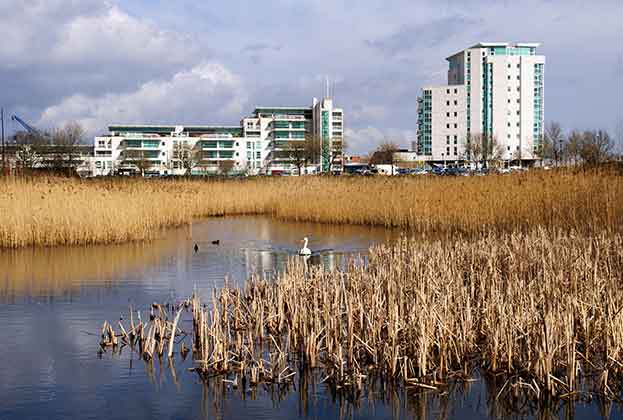Flood management, water storage and irrigation are key factors in ensuring that there is neither too much nor too little water available for users at any one time
Too much
Set out in the government’s 10-point plan for a green industrial revolution is a commitment to spend up to £5.2 billion over six years on flood defences in England, which would include using nature-based solutions to increase flood resilience. Flood management is a devolved issue and is not the responsibility of one single body, but many of the stakeholders involved, from local authorities to water companies, have made pledges to reach net zero carbon in their operations. Part of this challenge will require investment in “green” infrastructure over carbon-intensive hard engineering flood defence systems.
One such method is using catchment scale management to control water, such as re-meandering rivers and tree planting. These interventions can impact occupiers upstream to the benefit of downstream residents.
The Environment Agency (EA) in England has been advocating for payments to land managers to store water and assist with flood mitigation and says it is making progress with plans to factor this into Environmental Land Management (ELM). The first round of the Landscape Recovery scheme, under ELM, focuses on restoring streams and rivers to improve flood mitigation, working directly with farmers and land managers to develop projects that are financially viable and deliverable. However, this scheme targets larger landscapes and there is no guarantee similar opportunities will be available to smaller farmers.

Too little
While farming is only responsible for approximately 1% of abstracted water usage, agriculture holds approximately 64% of abstraction licences, demonstrating how exposed the industry is to changes in access.
The government’s 2017 Water Abstraction Plan sets out how it will reform abstraction management in England to protect the environment and improve access to water, contributing to the government’s 25 Year Environment Plan. There are three main elements to the plan: addressing unsustainable abstraction; building a stronger catchment focus, and modernising the abstraction service.
Much of the reform is already underway. More farmers are now required to seek a licence, including those using trickle irrigation. The reforms will end time-limited and seasonal licences, moving to timeless environmental permits that are subject to reviews, so abstraction can occur all year round during high flows within daily or annual limits. Farmers will benefit from the ability to merge abstraction licences so they have more flexibility over where the water is used and also become able to buy water rights from other licence holders.
CASE STUDY
THE TWEED FORUM – SCOTTISH BORDERS
Formed in 1991, the Forum promotes the sustainable use of the Tweed catchment through holistic and integrated management and planning, underpinned by the Tweed Catchment Management Plan. The plan creates a single management framework for the interacting and interdependent ecosystem services found in a 5,000km2 river catchment, allowing the integration of different administrative, planning and regulatory bodies in an attempt to manage the multiple demands on the catchment. It has developed into an award-winning, cross-border environmental partnership of 25 public and private sector organisations. A range of projects have been delivered from small-scale tree planting to river restoration initiatives working with stakeholders to achieve community-wide benefits, including cleaner water, increased resilience to flooding, enhancement of fish stocks, capture and storage of carbon and increased tourism in the area.
Welsh approach
To control water on land being developed, Sustainable Urban Drainage Systems (SuDS) are used to mimic natural drainage to reduce the impact of surface run-off. Since 2018 in Wales, development of one house or more requires SuDS designed in accordance with statutory standards. In England, SuDS are only required for “major developments” of at least 10 dwellings.
Water neutrality
In some local planning authority (LPA) areas, such as those in the Sussex North Water Supply Zone, the concept of “water neutrality” has emerged. Here, Natural England considers water abstraction to have a negative impact on wildlife and one way of preventing any further negative impact is to ensure all new development is water neutral, i.e. it does not increase the volume of water abstracted for public water supplies.
The focus is on both the water industry (via updated Water Resource Management Strategies) and LPAs, to produce up-to-date local plans with appropriate mitigation, to ensure that LPAs can meet their housing targets.

Irrigation reservoir creation
Government grants are an important catalyst
Abstraction reform means more farmers are turning to reservoirs to support farm water needs. Building a reservoir can be a long and complicated process. First, it is necessary to determine how to fill the reservoir, with the most common methods being via rainwater harvesting or by abstracting water. To abstract less than 20m3 a day, an abstraction licence is not required, but anything more needs approval from the Environment Agency. It is recommended to involve them early as flow monitoring may be required to ascertain whether there is sufficient water available.
Most small reservoirs will fall within permitted development rights provided extracted material is retained on-farm, meaning that a prior notification form can be completed instead of a full planning application. The Reservoirs Act 1975 (as amended) provides for an annual inspection regime for large above-ground reservoirs.
Over the years, the government has supported water retention and storage through a range of grants. Most recently, the Farming Transformation Fund provides grants towards large capital items to help businesses improve productivity, profitability, and environmental sustainability. It includes a Water Management Grant for projects such as securing water supply for crop irrigation through the construction of a reservoir or changing to a more efficient method of water application. The maximum grant is £500,000 and can cover up to 40% of the project cost. Following the close of the online check, the Rural Payments Agency has said the grant is oversubscribed and applications will be evaluated competitively.
Savills agents report that constructing a reservoir on irrigable land can add £1,000 per acre on to land values
Andrew Teanby, Associate Director, Rural Research
Savills analysis of full planning applications and prior notifications since 2013, (figure 3) shows that government grant support is an important catalyst and leads to a significant increase in the number of irrigation reservoirs constructed. The last round of funding, under the Countryside Productivity Scheme, resulted in a spike in applications with average reservoir construction rate in 2018 and 2019 291% higher than the preceding five-year average.
However, the number of applications without grant support remains above average, suggesting that farmers are choosing to make an investment in an asset that will increase the resilience of their business and can increase land values. Savills agents report that constructing a reservoir on irrigable land can add £1,000 per acre to land values, primarily because irrigation opens up opportunities to grow higher-value produce such as potatoes and root vegetables. Rental values also increase between 15% and 25%, depending on the type of land.
Read the other articles within Spotlight: Water below
.jpg)
